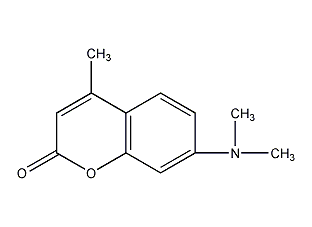
Structural formula
| Business number | 01XF |
|---|---|
| Molecular formula | C12H13NO2 |
| Molecular weight | 203.24 |
| label |
4-Methyl-7-dimethylaminocoumarin, 7-(Dimethylamino)-4-methyl-2H-1-Benzopyran-2-one |
Numbering system
CAS number:87-01-4
MDL number:MFCD00006862
EINECS number:201-717-3
RTECS number:GN6650000
BRN number:None
PubChem number:24846692
Physical property data
1. Character: colorless crystal 2. Density (g/mL,25/4℃): Undetermined 3. Relative vapor density (g/mL,Air=1): Undetermined 4. Melting point (ºC):274℃ 5. Boiling point (ºC,Normal pressure): Undetermined 6. Boiling point (ºC,5.2kPa): Undetermined 7. Refractive index: Undetermined 8. Flash Point (ºC): Undetermined 9. Specific optical rotation (º): Undetermined 10. Autoignition point or ignition temperature (ºC): Undetermined 11. Vapor pressure (kPa,25ºC):<0.01mPa(20ºC)Chlorine -8-Produced by the reaction of methylquinoline and azobisisobutyronitrile3,7-Dichloro-8-Prepared by hydrolysis of the reaction product of chloromethylquinoline and hydroxylamine hydrochloride.
Purpose
It is a hormone-type quinolinecarboxylic acid herbicide with strong selectivity.
For direct seeding of rice Fields and transplanted rice fields can effectively control barnyardgrass, saponaria, sesbania and other weeds. The control effect on barnyard grass is particularly outstanding. It can be made into wettable powder and suspending agent. Dosage: per hectare for seedling fields and direct seeding fields150~225gActive ingredients, transplanted rice Honda per hectare187.5gActive ingredients. Application period: rice2After the leaf stage, barnyardgrass1~7Can be applied at all leaf stages; use barnyard grass2~ 3The efficacy of the drug is best in the leaf stage; the transplanted rice Honda is best after transplanting the seedlings5~20Pesticides can be applied every day, per hectare to water750kgPerform spray application medicine. Drain the field water one day before application and after application1 ~2Days resume watering and maintain3~5cm‘s shallow water layer5~7天. Application of pesticides during the bud stage of rice is prone to phytotoxicity. Application of pesticides when the radicle is exposed in the early stage of rice sowing should be avoided. Apiaceae and Solanaceae crops are sensitive to this product, so care should be taken when applying the pesticide. To ensure safety, it is only suitable for rice transplanting fields; the following crops that can be planted after the rice harvest are eggplant, green mustard, watermelon and cowpea.
0pt; mso-ascii-font-family: ‘Times New Roman’; mso-hansi-font-family: ‘Times New Roman’; mso-bidi-font-family: 宋体”>The efficacy is best in the leaf stage; transplant Rice Honda after transplanting seedlings5~20Pesticides can be applied every day, with water per hectare750kgCarry out spray application. Drain the field water one day before application and after application1 ~2Days resume watering and maintain3~5cm‘s shallow water layer5~7天. Application of pesticides during the bud stage of rice is prone to phytotoxicity. Application of pesticides when the radicle is exposed in the early stage of rice sowing should be avoided. Apiaceae and Solanaceae crops are sensitive to this product, so care should be taken when applying the pesticide. To ensure safety, it is only suitable for rice transplanting fields; the following crops that can be planted after the rice harvest are eggplant, green mustard, watermelon and cowpea.

 微信扫一扫打赏
微信扫一扫打赏

